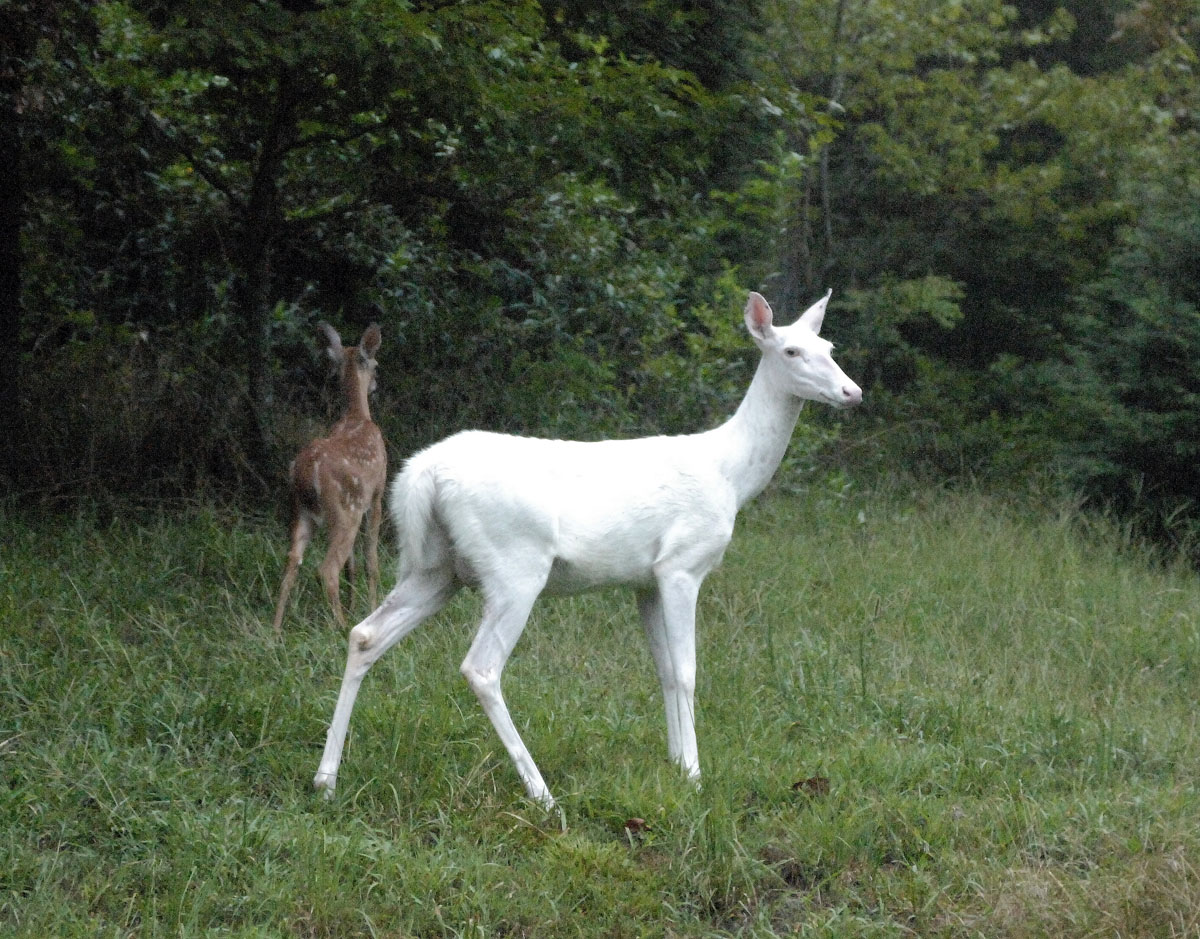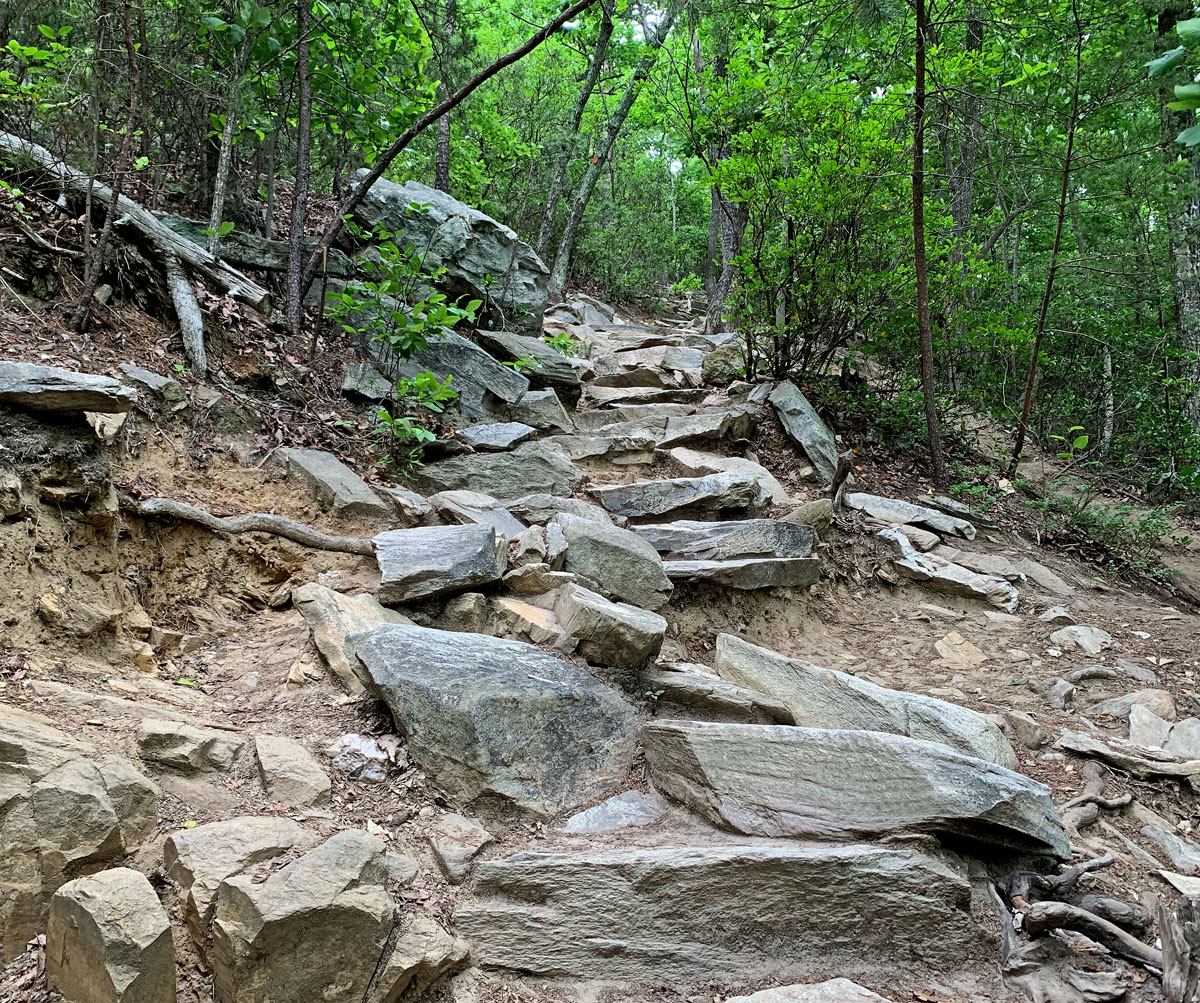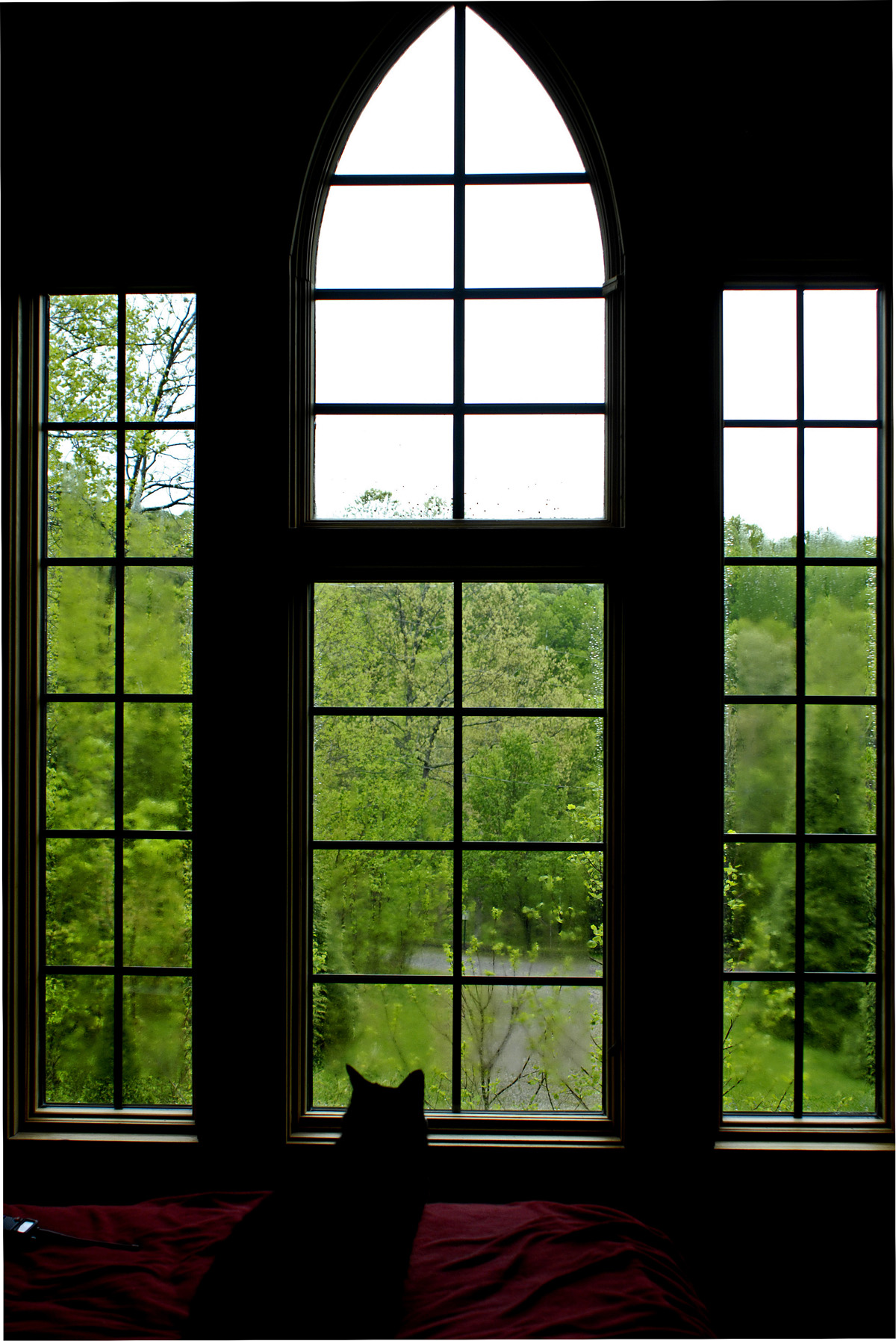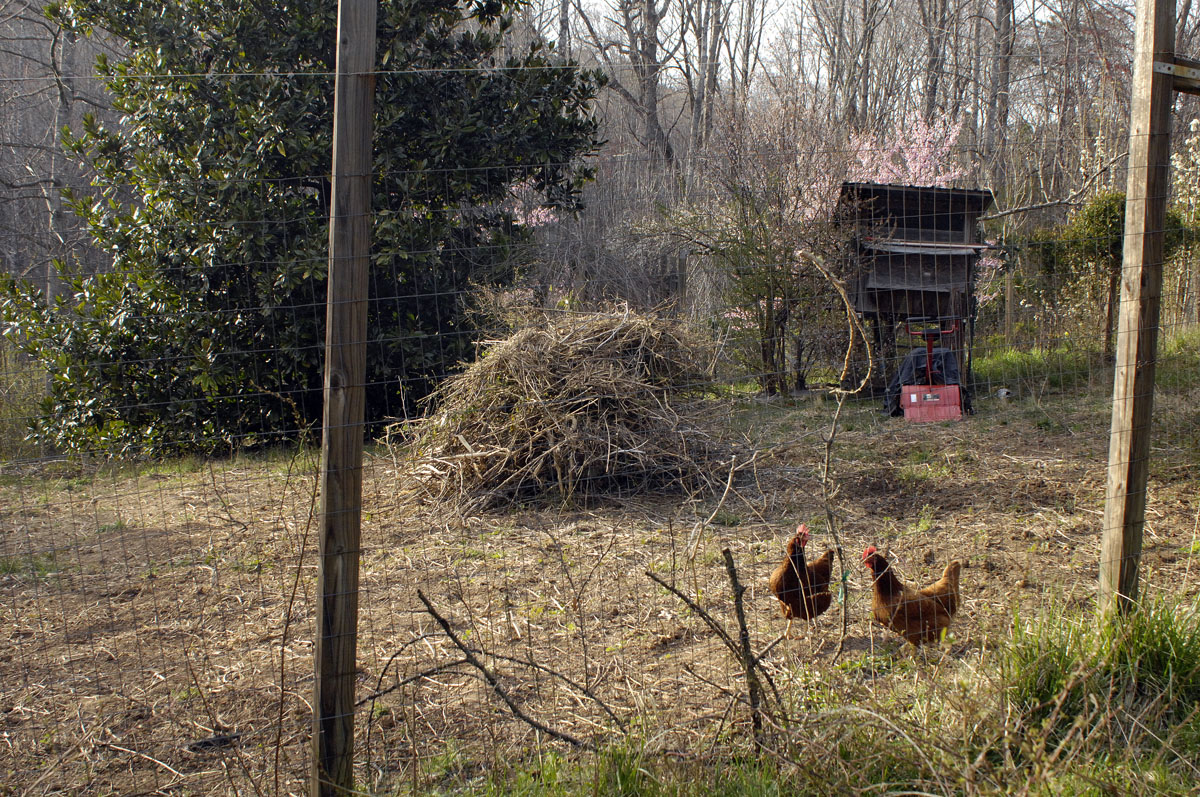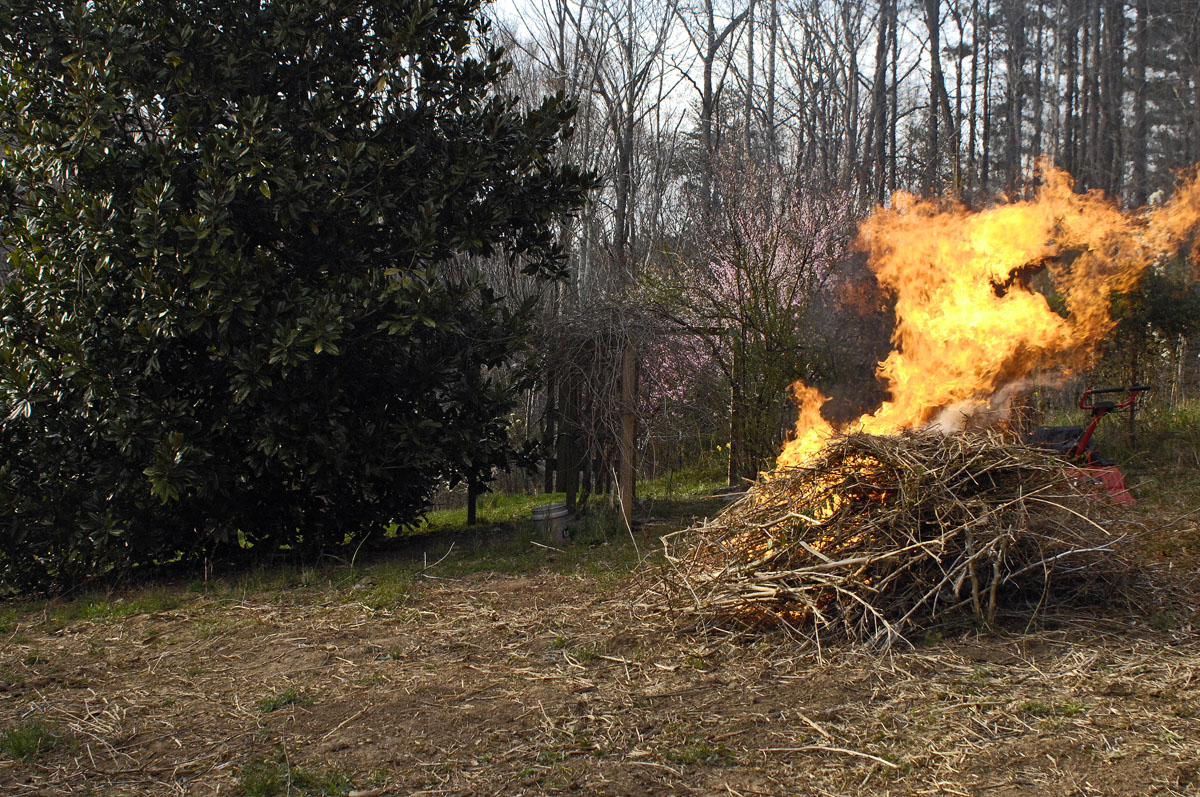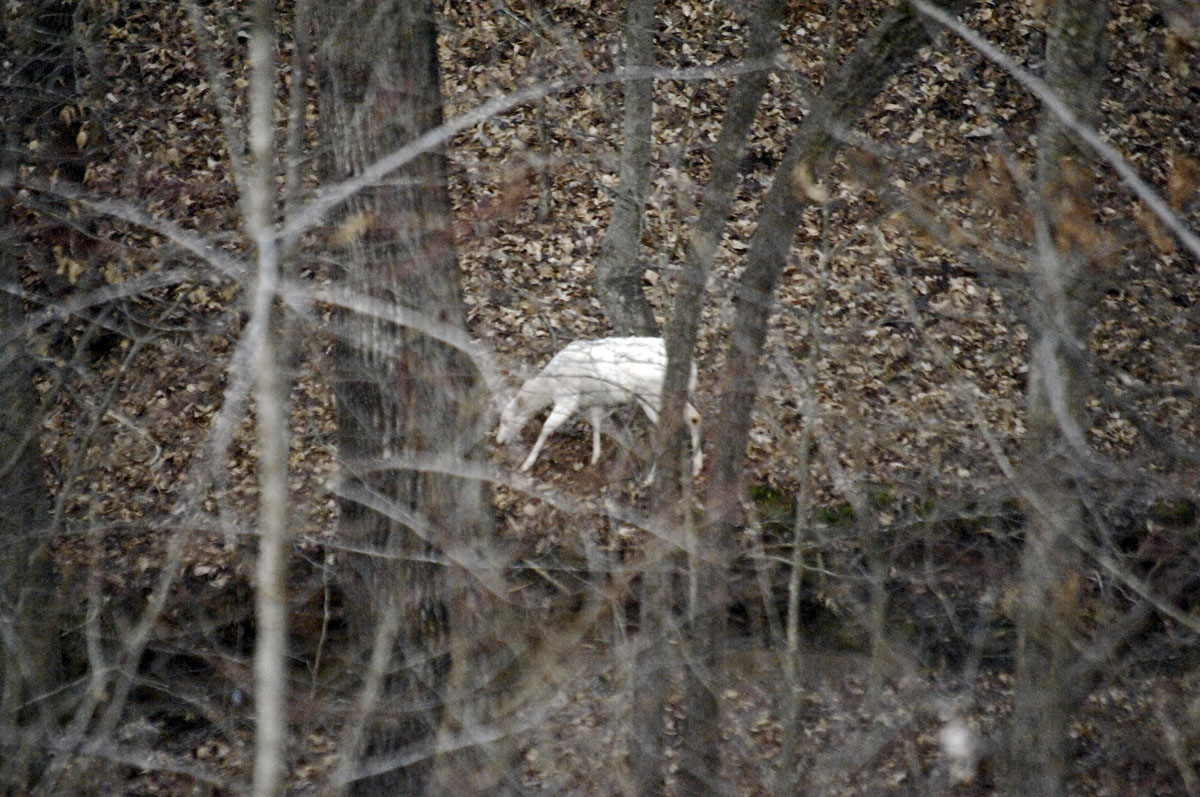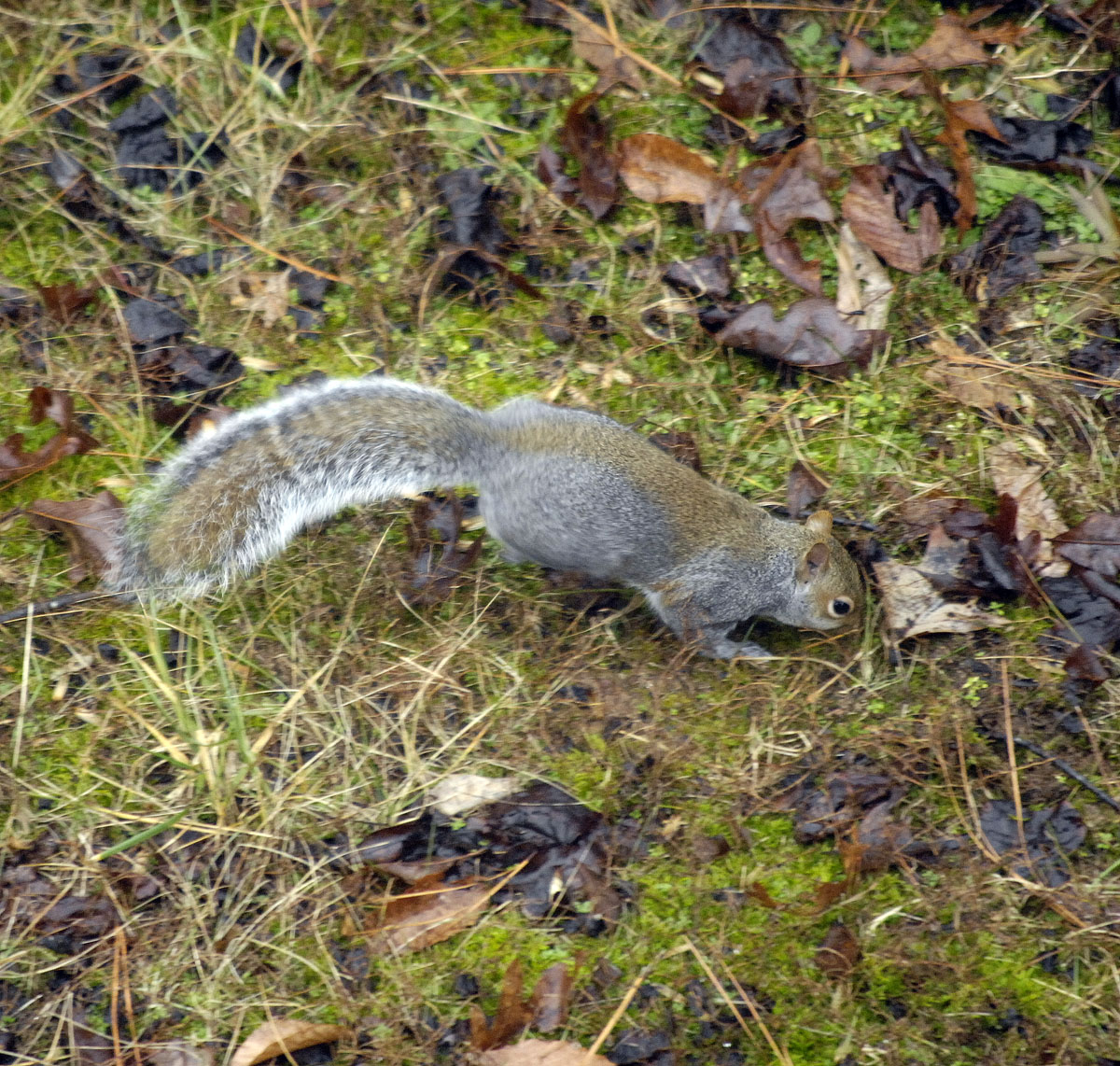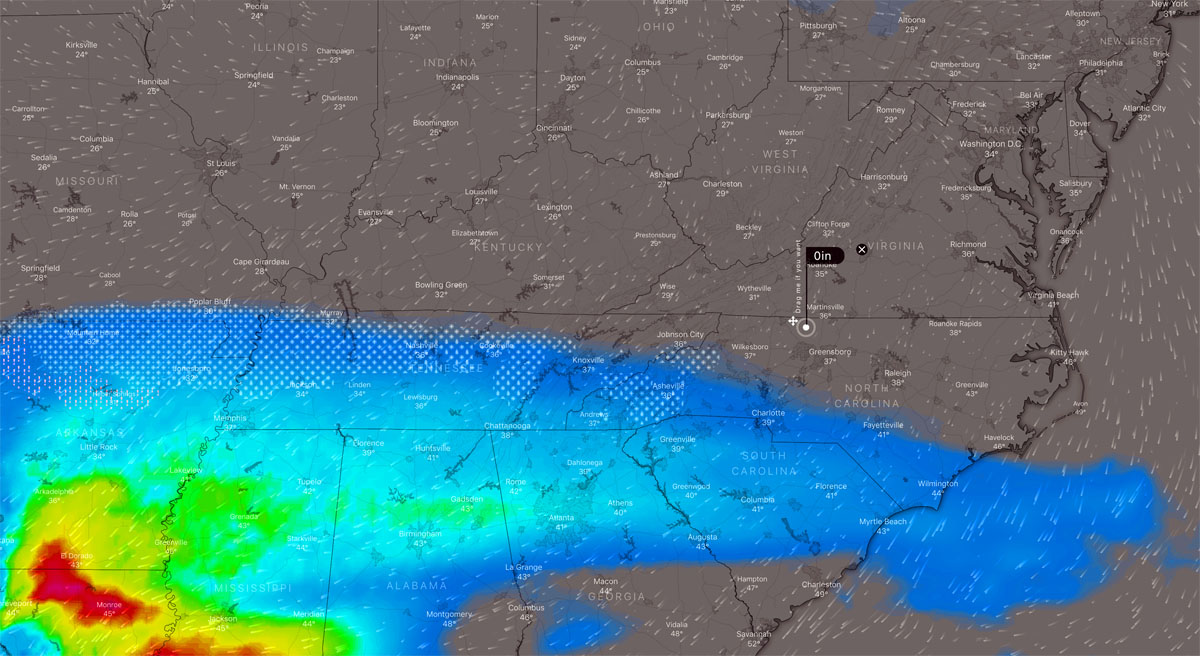The white deer is now well known in this area and is frequently seen on game cameras. I had not had a chance to photograph her in a while, though. She came through this morning with this year’s fawn. This would be at least the second year that she has raised a little one, and maybe the third. Everyone in the area looks out for her, and hunters have sworn to leave her alone.
Category: The land
A training ground for Highland hiking
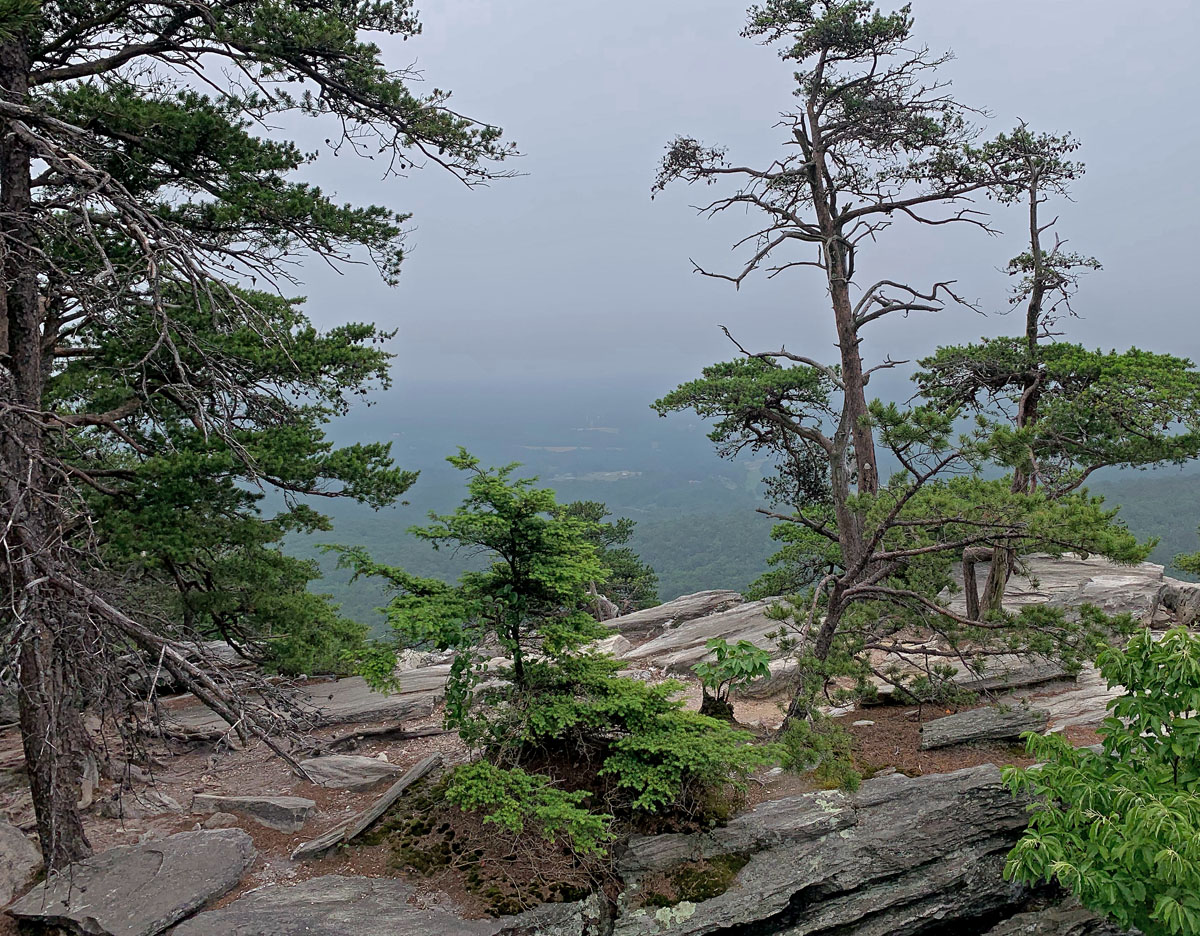
Looking south from the crest of Hanging Rock, with mist, just before rain
Though North Carolina’s Hanging Rock State Park is only a 15-minute drive from Acorn Abbey (through the picturesque little colonial town of Danbury), I don’t think I’ve ever written about the park here. These are iPhone photos that I took this morning.
The northern border of Stokes County, North Carolina, is formed by the state line between the states of Virginia and North Carolina. Just north of the Stokes County line, in Virginia, the Blue Ridge Mountains, part of the Appalachian chain, rise out of the foothills. Stokes County is a foothills county, but it has its own little mountain range — the Saura mountain range. Two mountains in this range are state parks — Pilot Mountain, and Hanging Rock. Both are fantastic promontories with extraordinary views from the top.
Like Pilot Mountain in the Yadkin Valley, Hanging Rock is a monadnock. Hanging Rock rises steeply out of the Dan River valley. Hanging Rock stands about 1,700 feet above the surrounding terrain. You could almost throw a rock from the top and have it land 1,700 feet below. The surrounding terrain — though you can see well into the Yadkin River valley — is the Dan River valley. The average altitude in the Dan River valley is about 800 feet above sea level. (We are about 265 miles from the Atlantic coast.) When you drive into Hanging Rock State Park, your car will get you to the visitors center at an altitude of about 1,700 feet. Then an uphill hike of about 1.3 miles will get you to the highest point in the park — Hanging Rock itself — at an altitude of 2,139 feet. The top photo was taken right on top of the USGS marker that officially marks the altitude.
The mountain is called Hanging Rock not because anybody was ever hanged there, but because a large outcropping of rock hangs out over the terrain below.
Last summer, when I was training for a hiking trip to the Scottish highlands and islands, Hanging Rock was my go-to place. At only 2.6 miles round trip, it’s not a long hike, but it’s intense. My Apple watch shows an altitude gain of 50 floors in only 1.3 miles. Most of the trail is uphill through woodland. But the last half mile or so is very steep, over a rough terrain of rocks and soil. Finally you reach the crest, the top of the monadnock. The top is fairly flat, a wooded acre or so with views in all directions.
As you might have guessed, I’m training again for another trip to Scotland, this time to the Outer Hebrides, in August. I’ve already hiked enough in the Scottish islands to know that, as in Stokes County, there is no such thing as flat land. It’s up and down, and always over uneven terrain. The only thing that a place like Hanging Rock cannot prepare you for is hiking in a bog. Nothing but hiking in a bog is like hiking in a bog. Still, uneven terrain in a bog, with lots of ankle-breakers, is a lot like uneven terrain over rocks, bog or no bog. If you’re my age, a hiking stick is an essential item.
The August trip to Scotland will include a couple of days in Edinburgh. Then the itinerary is Inverness, Ullapool, Stornaway, Mangersta, Aird a’ Mhulaidh, Lickisto, Tarbert, Kilmuir, Edinburgh. Though I’m flying into Heathrow, I’ll be bypassing London this trip and traveling through Oxford instead. I’ve never been to Oxford. Oxford will be one of the settings in my third novel, so I need see the place and do a little pub-hopping.
Two kinds of light
On a rainy day this time of year, it’s hard to stay away from the windows. Above, rain is falling, and the windows are wet and a bit foggy. Below, it’s the morning after the rain, and the sun has come out. The woods are rapidly turning green, but the leaves are only about half out. Lily is in her favorite spot.
2019 Garden: Here we go
The first garden chore of the year is to clear, and then to burn, last year’s dead weeds. That got done today.
The next garden chore of the year is the first tilling. That will get done tomorrow, ahead of a light rain that is due to start about 5 p.m.
After that, the next garden chore of the year will be to till again and to plant onions and cabbages. That will be done by Friday, ahead of a rainy spell that is now in the forecast.
Some people plant by the astrological calendar. Good luck to them. I plant with the weather. I want to get my onion sets and cabbage plants in just before the next rainy spell.
The chickens, having worked the garden all winter, will be allowed into the garden until planting begins. After that, the garden gate will be closed, and they’ll be banned to the woods and orchard (which is more than enough pasture for them). They love to pick through the garden, though, looking for worms and grubs. There are plenty of worms, and they’re welcome to the grubs.
A useless detail: My Apple watch tapped me six times today while I was hacking at blackberry briars with a hoe. It asked me if I had fallen. It worries too much. Its fall detector seems to be particularly sensitive to any kind of vigorous flailing of the arms.
All’s well with the white deer
The white deer came through this morning, accompanied by four or five other does. The abbey sits in a little valley, and I’m pretty sure that the white doe and her friends and family never venture across the ridges. She is well known now in this area and is frequently seen. The photo was taken from an upstairs window.
A chicken story with a happy ending

One of many feathers found at the scene
I was sitting at the computer upstairs when I heard the chickens screaming. I dashed to the side porch, slipped on my shoes without tying them, grabbed a broom, and ran toward the orchard yelling.
The battle was happening on the far upper end of the orchard, beyond the asparagus patch. I couldn’t see the battle clearly through the weeds and honeysuckle that grow on the fence. One chicken ran out of the undergrowth and headed toward the garden. But from the sound it was clear that another chicken was still engaged. Not until I loomed over the scene of the crime with my broom did the hawk try to get away. It crashed against the fence several times before it realized that it had to fly toward me to escape. I could have knocked it out of the air with my broom if I had tried, but I couldn’t bring myself to do it.
A terrified chicken got up from the ground, dazed. She didn’t seem to be injured. She stumbled toward the chicken house, climbed the ramp, went inside, and cringed in one of the nests in a corner, trembling. The chicken that had run to the garden was fine, though scared out of her wits. It took me a while to find the third chicken. She had gone to ground down below the chicken house, hiding under some brush. She answered when I spoke to her and extricated herself from the brush. I escorted her to the chicken house to comfort her sister.
If chickens have the freedom that they love and deserve, then hawks are the biggest problem. Dogs, foxes, and coyotes have never gotten through the fences here. Raccoons only come at night, when the chickens are locked safely inside the chicken house.
The local hawks — Cooper’s hawks, I believe — are not any bigger than a chicken. A chicken that puts up a good fight can escape a hawk attack. What’s funny about this hawk attack (the first attack I’ve had since last summer) is that I am pretty sure that two chickens were fighting the hawk. That’s not what I would have expected. I would expect all the chickens to run except for the one that can’t get away. One of my chickens, I suspect, deserves a medal for bravery.
Everyone who has had chickens in this area struggles with the same question: Is it worth it? Is it fair to expose chickens to a danger from which you can’t fully protect them? The chicken infrastructure here is better than what most people can provide. Most chickens here live to be several years old. Those years are good, happy years. This is my eleventh year of keeping chickens here. I’m not ready to give up. Nor can I blame hawks for being hawks. I just wish they’d stay away. I hope this one learned a lesson.
According to PETA, 9 billion chickens are killed each year in the U.S. to be eaten by humans. Worldwide, the number is 50 billion. Their lives are as terrible as their deaths. Misery on that scale is existentially incomprehensible to me. If you’ve ever gotten to know a chicken, you know what sweet, sensitive, emotional creatures they are. A happy chicken that can truly live like a chicken is a rare thing. My chickens live that way most of the time. Their vulnerability is disheartening. But it’s wonderful to see them fight for their lives — and win.
There were lots of feathers at the scene of the crime. Most were clearly chicken feathers. There was one large feather that I believe is a wing feather from a hawk. Way to go, girls.
Where the squirrels live
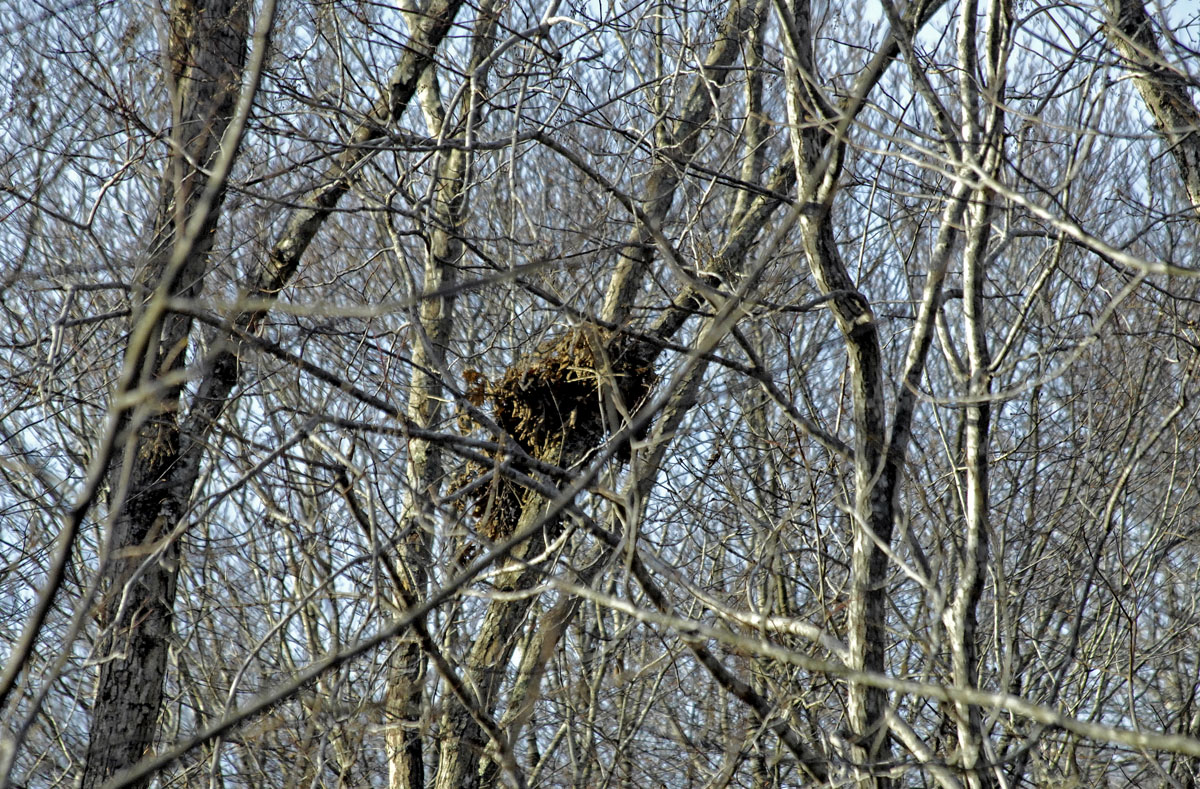
Shot with a 200mm lens from an upstairs window. Click here for high-resolution version.
From my upstairs office window, during the winter, I can see deep into the woods, up to the top of the next ridge, and down to the little rocky stream below the house. I also can watch the squirrels going about their business in the trees. I have a pretty good view of two squirrel nests, though binoculars would be needed for proper squirrel-watching.
Of all the creatures in the woods, squirrels have the best — and I suspect the safest — homes. They have to worry about hawks and owls from above, and foxes and coyotes from below, but my guess is that squirrels are caught less often than animals such as rabbits that can’t climb trees.
For many animals in these latitudes (including squirrels, I suspect), the best habitat is to be found where forest comes up against meadow. In a forest, the canopy catches most of the sun. But in a meadow, the sun reaches the ground, and all the growth is different. At the borders of woods and meadows, wildlife gets the benefits of both worlds.
As much as I hate seeing woods cut down for timber, I have to admit, having watched such areas begin to recover, that after the shock of the loss of woodland habitat, many species benefit as low-growing plants take over. Deer and rabbits love it. It’s also how humans managed to subsist when they first started living in the Appalachian forests. They would cut, or burn, a hole in the forest. For subsistence, they required both kinds of terrain — woodland and farmable meadow. When a natural event such as a fire clears an opening inside a healthy forest, that opening becomes a kind of oasis. Even if one big tree falls, and sunlight suddenly reaches the ground, all sorts of growing things take advantage of the opportunities.
I like reflecting on this, because I think it shows that rural living is sustainable — farmland alternating with woods. A recent Gallup poll found that most Americans would prefer rural living to a city, a suburb, or a small town. Rural living, I believe, is a privilege, because it’s not an option available to most people, given the kind of economy we have today.
In the photo below, one of my squirrel neighbors is working the yard for food. I’m not sure what. Skunks, raccoons, moles, and birds mine the yard for grubs, especially during the winter. But as far as I know, squirrels don’t eat grubs.
Speaking of moles, most people regard them as pests. I find them to be very beneficial. In mining for grubs, they do a beautiful job of aerating the soil. Grass flourishes in areas that the moles have cultivated.
The white matriarch
A troupe of five does passed through the yard this morning, with the white deer in the lead. She has been around for at least three years now, so she seems to have become a matriarch. I don’t worry too much anymore about her getting shot. It’s my understanding that all the hunters in the area are aware of her and have taken an oath not to shoot her. Deer season ends Jan. 1. It’s always a relief when deer season ends.
How do the birds know that snow is coming?
Photo update: Snowmageddon arrives:
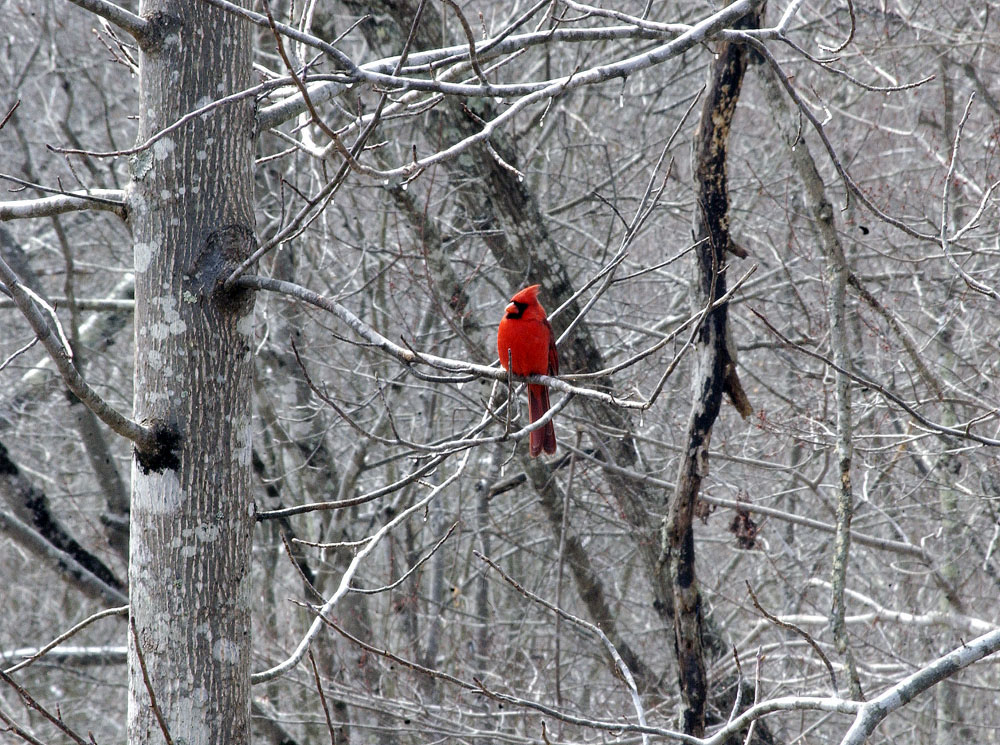
A file photo taken here in March 2014 — a cardinal
While looking out the upstairs windows with Lily this morning, it was apparent that the birds were unusually active and agitated. The traffic into and out of the arbor vitae trees was particularly busy, as though the birds are laying claims to shelter space from the heavy snow that is forecast here for tonight and tomorrow.
All of the arbor vitae trees (there are 14 of them in the abbey’s front yard) have little openings in the foliage that the birds use for flying in and out. I’m pretty sure that the openings actually are made by the birds and their frequent traffic. The birds can fly straight in with little or no wing contact. Watching even for a little while, it’s apparently that a single arbor vitae tree shelters many birds, and different species at the same time. They fly in at different levels. Six or more levels per tree would be my guess.
There is an English word for what I think these openings might be called — smeuse. I have never heard this word used, but Robert Macfarlane’s book Landmarks, on the rewilding of the landscape through language, defines smeuse as “the gap in the base of a hedge made by the regular passage of a small animal.” I don’t know whether the word also would apply to a hedge-like tree. I hope it does. Maybe readers in the U.K. could shed light on that question?
When there is heavy snow, it’s always a problem finding a place to put bird seed where the birds can get it. It occurs to me that just throwing food into the arbor vitae trees might work.
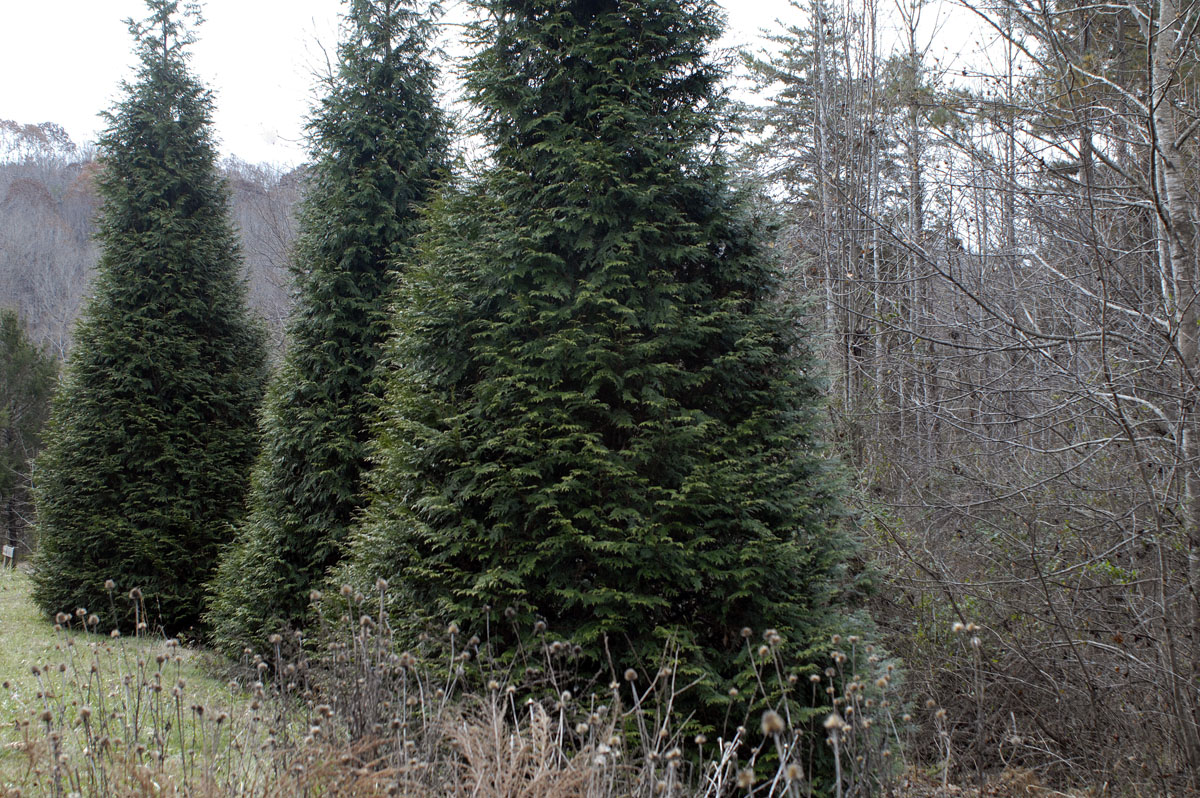
Some of the abbey’s arbor vitae trees

Doorways for birds. Are they smeuses?

The human equivalent: All the milk (except for the organic milk!) has vanished two days before the storm is due.
Lookin’ good, Skwurlikins …
This squirrel is such a regular visitor to the house that I ought to give him or her a name. Sometimes he gets on the roof. Sometimes he peeks in an upstairs dormer window. And sometimes he tries to break through the screen of an attic vent, in which case I go out to chase him away. On this particular day, he just sat on the deck for a while, looking relaxed and contemplative. It must have been a good year for the squirrels. He looks well fed, with a fine bushy tail. I don’t feed the squirrels or encourage them. They’d soon get out of hand.

